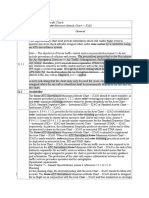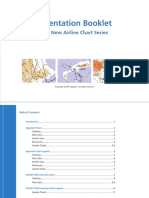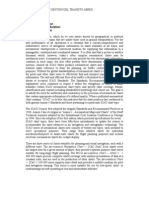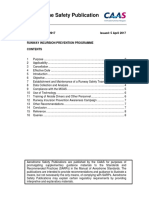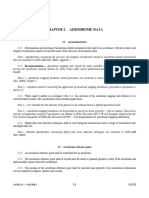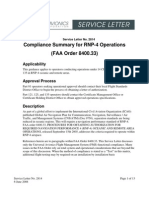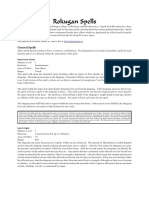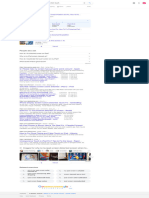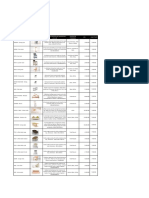Advisory Circular: AC 139-17 (0) Preparing Plans For Inclusion in Aerodrome Manuals
Advisory Circular: AC 139-17 (0) Preparing Plans For Inclusion in Aerodrome Manuals
Uploaded by
aapierro13Copyright:
Available Formats
Advisory Circular: AC 139-17 (0) Preparing Plans For Inclusion in Aerodrome Manuals
Advisory Circular: AC 139-17 (0) Preparing Plans For Inclusion in Aerodrome Manuals
Uploaded by
aapierro13Original Description:
Original Title
Copyright
Available Formats
Share this document
Did you find this document useful?
Is this content inappropriate?
Copyright:
Available Formats
Advisory Circular: AC 139-17 (0) Preparing Plans For Inclusion in Aerodrome Manuals
Advisory Circular: AC 139-17 (0) Preparing Plans For Inclusion in Aerodrome Manuals
Uploaded by
aapierro13Copyright:
Available Formats
Advisory Circular
AC 139-17(0)
MARCH 2005
PREPARING PLANS FOR INCLUSION IN
AERODROME MANUALS
CONTENTS
1.
REFERENCES
1.
References
2.
Purpose
3.
Status of this AC
4.
Background
5.
Definitions
6.
General Survey and Plan Details
Manual of Standards (MOS) Part 139
Aerodromes Chapter 5.
7.
Aerodrome Facilities Plan
ICAO Annex 4 Aeronautical Charts.
8.
Aerodrome Boundary Plan
9.
Aerodrome Location Plan
10. Further Information
1.1
This Advisory Circular
should be read in conjunction with:
(AC)
Appendix 1 to subparagraph
139.095 (a) (i) of the Civil Aviation
Safety Regulations 1998 (CASR).
2.
PURPOSE
2.1
The purpose of this AC is to
provide aerodrome operators with some
guidelines when preparing aerodrome plans,
as required by CASR Part 139, for inclusion
in their aerodrome manual.
3.
STATUS OF THIS AC
3.1
This is the first AC to be written on
the subject of preparing plans for inclusion
in an aerodrome manual.
Advisory Circulars are intended to provide advice and guidance to illustrate a means, but not
necessarily the only means, of complying with the Regulations, or to explain certain regulatory
requirements by providing informative, interpretative and explanatory material.
Where an AC is referred to in a Note below the regulation, the AC remains as guidance
material.
ACs should always be read in conjunction with the referenced regulations
March 2005
4.
AC 139-17(0): Preparing Plans for Inclusion in Aerodrome Manuals
BACKGROUND
4.1
Appendix 1 to subparagraph 139.095 (a) (i) of CASR Part 139 sets out the
requirement for operators of certified aerodrome to include a number of plans in their
Aerodrome Manuals. A minimum of three plans are called for in the Schedule:
(a) a plan of the aerodrome and its facilities;
(b) a plan of the aerodrome boundaries; and
(c) a locality plan of the aerodrome relative to the main town centre.
4.2
The need for guidance material in preparing these plans has been identified by
CASA staff undertaking aviation safety audits of aerodrome manuals, as the content and
quality of plans included in aerodrome manuals varies greatly.
4.3 As there are no standardised format or content details in CASR Part 139, or in the
MOS Part 139, CASA has provided this AC to help operators in the preparation of these
plans. This would then assist CASA to assess compliance with the CASR Part 139
requirements. In addition, a suggested list of items to be included on the plans is also
outlined in the following sections.
4.4 Other plans, such as an Obstacle Limitation Surfaces plan, may also be required
depending on the size and scale of the aerodrome operation. Aerodrome operators will
need to speak with their local CASA Aerodrome Inspector to determine the need for these
additional plans.
5.
DEFINITIONS
Above Mean Sea Level (AMSL): Mean sea level is the arithmetic mean of the hourly
heights of the sea at the tidal station measured over a period of time (usually 19 years or
more).
Australian height datum (AHD) is the vertical reference datum that passes through mean
sea level at thirty tide gauges located around the Australian coastline.
World Geodetic System 1984 (WGS-84) is the geodetic reference datum adopted by CASA
in 1995 for the determination of latitudes and longitudes applicable to Australian aviation.
WGS-84 is a consistent set of parameters describing the size and shape of the earth and the
position of a network of points with respect to the centre of the earth's mass. Global
Positioning Systems (GPS) uses WGS-84 as its geodetic referencing system.
6.
GENERAL SURVEY AND PLAN DETAILS
6.1
It is suggested that the following principles be adopted when considering the
general survey requirements and the drafting layout details.
6.2
Elevations and Distances
6.2.1
All elevations should be shown in metres AHD. All distances should be shown
in metres. Ideally the plan should have a WGS-84 overlay specifying the nearest meridians
of latitude and longitude.
March 2005
AC 139-17(0): Preparing Plans for Inclusion in Aerodrome Manuals
6.3
Plan size
6.3.1
The size of the plan should be commensurate with the size and complexity of the
aerodrome; however ideally, an A3 or A4 paper copy should be included in the aerodrome
manual.
6.3.2
For readability, the plans should also be available in A1 paper size.
6.4
Materials
6.4.1
All plans should be either black ink or colour ink on white paper.
6.5
Scale
6.5.1 The plans should be to a scale suitable to the A3 paper size, however a scale of
between 1:3000 and 1:5000 for the Aerodrome Facilities Plan and the Aerodrome
Boundary Plan is recommended.
6.5.2
6.6
All plans should be clearly labelled with the scale used, including a bar scale.
North Point
6.6.1
True north, and the magnetic declination (including the degree of annual
variation, the direction and the year) should be shown.
6.7
Symbols
6.7.1
Standard survey symbols should be used to represent items on the plan. Where
there is no standard survey symbol available - then the ICAO map symbols, as illustrated
in Annex 4 Aeronautical Charts, should be used.
6.8
Drafting standards
6.8.1
Drafting standards should conform to Australian Standards ~ AS 1100.
6.9
Survey Accuracy
6.9.1
Survey accuracy should be commensurate with the size and scale of the
aerodrome involved.
6.9.2
Horizontal distances should be represented on plans rounded down to the nearest
whole metre.
6.9.3
As elevations in the aviation system are based on imperial measurements (i.e.
feet) the height of elevations on the plan should be given to the nearest whole foot.
6.9.4
The Runway azimuths should be measured to an accuracy of 10 seconds of arc.
7.
AERODROME FACILITIES PLAN
7.1 It is suggested that the following principles be adopted when producing the
Aerodrome Facilities Plan.
7.2
Title
7.2.1
The title of the plan should be clearly shown in the bottom right hand corner of
the plan with the name of the aerodrome and the words Aerodrome Facilities Plan.
March 2005
7.3
AC 139-17(0): Preparing Plans for Inclusion in Aerodrome Manuals
Content
7.3.1 Where applicable, the following facilities should be included on the Aerodrome
Facilities Plan:
runways with dimensions labelled
runway surface types (concrete, asphalt, sealed, gravel, grass)
runway end elevations (in metres AHD)
runway strip with dimension labelled
runway strip end elevations (in metres AHD)
key runway chainages
runway markers and markings
runway strip markers
stopways
clearways
runway end safety areas
taxiways with names (Alpha, Bravo, etc.)
taxiway surface types (concrete, asphalt, sealed, gravel, grass) labelled
taxiway markers and markings
aprons with names (RPT, GA, Tie Down Area, Private) and types (concrete, asphalt,
sealed, gravel, grass) labelled
apron markings (see paragraph 7.6)
aerodrome lighting facilities (see paragraph 7.7)
navigational aids labelled with type (NDB, VOR, DME, etc, with critical and
sensitive areas identified where possible)
localiser array aerials (with critical and sensitive areas shown)
glide paths (with critical and sensitive areas shown)
airside roads
terminal buildings
fire stations
control towers
other airside buildings
other main buildings relevant to the operation of the aerodrome
primary wind indicator
secondary wind indicators (indicate if lit or unlit)
compass swing sites
signal circle
airside/landside perimeter fence
March 2005
AC 139-17(0): Preparing Plans for Inclusion in Aerodrome Manuals
airside/landside perimeter gates (with gate numbers labelled)
heliports, helicopter aiming points, helicopter landing sites
visual landing aids (T-VASIS/ AT-VASIS or PAPI)
approach lights
aerodrome reference point (including elevation)
lit obstacles on the aerodrome
drains with type (open unlined, U/G, etc) labelled
meteorological facilities
fixed fuel installation
7.3.2
It should be noted, that it may be necessary to have more than one plan to
accommodate all of this detail. For example, at large complex aerodromes separate plans
for the apron markings and lighting facilities would most likely be needed.
7.4
Permanent survey marks
7.4.1 The position of permanent survey marks (PSM's) at the end of each runway should
be indicated, if they have been installed on the aerodrome.
7.5
Runway chainages
7.5.1
The origin of the runway chainage should be such that there are never any
negative chainages on the plan.
7.5.2
Always commence the chainages at the end of the runway with the lowest number
i.e. for Runway 12/30 start the chainage at the Runway 12 end.
7.5.3
The plan should ideally identify the chainages at all major points along the
runway, including:
runway strip end
runway end safety areas
clearway end
stopway end
runway end
runway threshold
runway intersections
taxiway intersections
commencement and conclusion of turning nodes
access roads to the runway
7.6
7.6.1
Apron Areas
The apron area should be clearly identified.
7.6.2 If the apron is complex, or the aerodrome has commercial passenger aircraft
operations above 5700kgs maximum take off weight (MTOW), a separate Apron Facilities
Plan should be included in the aerodrome manual.
March 2005
AC 139-17(0): Preparing Plans for Inclusion in Aerodrome Manuals
7.6.2
If a separate Apron Facilities Plan is being prepared, it should show all of the
facilities on the apron area. This would include:
apron markings associated with the movement and parking of aircraft
aircraft parking bay designations clearly labelled
apron markings associated with the parking of vehicles and equipment
apron markings associated with the operation of vehicles and equipment
earthing points
hydrant refuelling points
location of any nose in guidance systems
any run-up bays or engine start positions
the limits of the apron area
any buildings that front onto the apron
access gates to the airside in the area
a table showing the maximum size aircraft each bay is designed for
the co-ordinates of any aircraft parking positions fitted with a nose in guidance system
a table showing any restrictions on the use of the apron
7.6.3
The scale of the Apron Facilities Plan should be commensurate with the size and
scale of the apron area being depicted. The plan should be large enough to show all of the
apron facilities and use of multiple plans to cover a large area may be necessary.
7.7
Aerodrome lighting facilities plan
7.7.1
Where there is a lighting system installed at the aerodrome, a plan showing the
location of the facilities for the operation of the lighting system should also be included in
the aerodrome manual.
7.7.2
If a separate aerodrome lighting facilities plan is being prepared, it should show
all of the facilities at the aerodrome used for the operation of the lighting system. This
would include:
approach lights
runway threshold identification lights
runway edge lights
runway end lights
runway threshold lights
stopway lights
turning node lights
runway guard lights (wig wags)
visual landing aids (T-VASIS/ AT-VASIS or PAPI)
taxiway lights
apron flood lights
March 2005
AC 139-17(0): Preparing Plans for Inclusion in Aerodrome Manuals
apron edge lights
obstacle lights on the aerodrome
illuminated wind indicators
helicopter landing site lights
control cables
8.
AERODROME BOUNDARY PLAN
8.1 It is suggested that the following principles be adopted when producing the
aerodrome boundary plan.
8.2
Title
8.2.1
The title of the plan should be clearly shown in the bottom right hand corner of
the plan with the name of the aerodrome and the words Aerodrome Boundary Plan.
8.3
Boundary
8.3.1
The plan should clearly show the boundary of the area of the aerodrome expressly
set aside for aerodrome purposes. This would normally be the area shown on the
aerodrome Certificate of Title.
9.
AERODROME LOCATION PLAN
9.1
It is suggested that the following principles be adopted when producing an
aerodrome location plan.
9.2
Title
9.2.1
The title of the plan should be clearly shown in the bottom right hand corner of
the plan with the name of the aerodrome and the words Aerodrome Location Plan.
9.3
Plan format
9.3.1
The aerodrome location plan should be presented on a background showing the
general topographical features of the area, i.e. river, creeks, hills, etc.
9.3.2
The aerodrome location should be shown against the background of other features
such as roads, railway lines, nearest town and other significant geographical features.
9.3.3
An up to date topographical database should be used and the plan should be
regularly updated.
9.4
North point
9.4.1
The aerodrome location should be located with north up the page, and the north
point clearly shown.
March 2005
9.5
AC 139-17(0): Preparing Plans for Inclusion in Aerodrome Manuals
Distance to nearest town
9.5.1
The plan should be clearly labelled with the distance in nautical miles (to one
decimal point) and magnetic bearing to the nearest town, settlement or homestead. The
location for the centre of the town is to be the Post Office or General Store if there is no
Post Office.
9.6
Other aerodrome facilities
9.6.1
The aerodrome location plan should show any aerodrome facilities that are located
outside of the aerodrome boundary. This may include:
radar equipment located off aerodrome
obstacle lights located on adjacent hills or other nearby obstacles
approach lights, located off aerodrome land
navigational aids located away from the aerodrome
10.
FURTHER INFORMATION
10.1
For further information on how to prepare a plan for inclusion in an Aerodrome
Manual contact your local CASA Aerodrome Inspector or the Aerodrome Specialist in the
Operational and Flight Crew Licensing Standards Branch of CASA. Telephone 131 757
(for the cost of a local call) and ask for the Aerodrome Inspector in your area.
Rowena Barrell
Acting Executive Manager
Aviation Safety Standards
March 2005
You might also like
- 737 Performance Reference Handbook - EASA EditionFrom Everand737 Performance Reference Handbook - EASA EditionRating: 4.5 out of 5 stars4.5/5 (3)
- International Civil Aviation OrganizationDocument26 pagesInternational Civil Aviation OrganizationDiana AleNo ratings yet
- Aircraft Classification Numbers On Flexible PavementsDocument4 pagesAircraft Classification Numbers On Flexible PavementspoketupiNo ratings yet
- TGM For Declared Distances RESA CalculationDocument6 pagesTGM For Declared Distances RESA CalculationanNo ratings yet
- Advisory Circular: Federal Aviation AdministrationDocument18 pagesAdvisory Circular: Federal Aviation AdministrationLiki TriwijayaNo ratings yet
- Appendix JDocument8 pagesAppendix Jaapierro13No ratings yet
- TE Chapter 6Document18 pagesTE Chapter 6Htet HtetNo ratings yet
- 1 AD1 - 2006 May 2022 Guidelines For Preparation and Maintenance of Aerodrome ManualDocument12 pages1 AD1 - 2006 May 2022 Guidelines For Preparation and Maintenance of Aerodrome ManualdineshonlineNo ratings yet
- AED Design Requirements - HelipadDocument56 pagesAED Design Requirements - HelipadPong PanugaoNo ratings yet
- Introduction To Jeppesen Navigation Charts 2011Document78 pagesIntroduction To Jeppesen Navigation Charts 2011John ArevaloNo ratings yet
- Guidance Material On Aerodrome ICAO Annex 14 SurfacesDocument21 pagesGuidance Material On Aerodrome ICAO Annex 14 SurfacesAbu Zulkarnain Abu BakarNo ratings yet
- City of Chandler Airport Master Plan Appendix D Airport Layout Plan Dec 2021Document20 pagesCity of Chandler Airport Master Plan Appendix D Airport Layout Plan Dec 2021George Fish100% (1)
- CAAPDocument54 pagesCAAPDonnafe IresoNo ratings yet
- Operations Circular: Subject: Aircraft and Operators Approval For RNP 1 OperationsDocument39 pagesOperations Circular: Subject: Aircraft and Operators Approval For RNP 1 Operationsmehul da aviatorNo ratings yet
- ASD 503 Aerodrome DataDocument18 pagesASD 503 Aerodrome DataelbaraniNo ratings yet
- A380 PPD Classe eDocument14 pagesA380 PPD Classe egiant360No ratings yet
- Global Navigation Satellite System (GNSS) Manual: Doc 9849 AN/457Document68 pagesGlobal Navigation Satellite System (GNSS) Manual: Doc 9849 AN/457Đoàn Hồng NgọcNo ratings yet
- Section Six Airport Layout Plan Drawings: Campbell & Paris Engineers (Document4 pagesSection Six Airport Layout Plan Drawings: Campbell & Paris Engineers (Chen Inn TanNo ratings yet
- Airport Layout Plan For Efficient Airport DesignDocument8 pagesAirport Layout Plan For Efficient Airport Designvram786No ratings yet
- CA 314-2.1-2018 FinalDocument32 pagesCA 314-2.1-2018 FinalDavid DanielNo ratings yet
- 1.3 Rapid Exit Taxiways (Rets) General: Aerodrome Design ManualDocument12 pages1.3 Rapid Exit Taxiways (Rets) General: Aerodrome Design ManualUmesh Bindu Shrestha0% (1)
- Text Instrument Flight ProceduresDocument56 pagesText Instrument Flight ProceduresGuilioNo ratings yet
- Jeppesen Intro PDFDocument78 pagesJeppesen Intro PDFBAZOUKNo ratings yet
- Albany AMP CH 8 ALP Draft Final W ALPDocument16 pagesAlbany AMP CH 8 ALP Draft Final W ALPAhmed Subhi AbdaljabbarNo ratings yet
- General: Chapter 7. Preparation of Specific Charts Radar Minimum Altitude Chart - ICAO Annex 4 ReferenceDocument9 pagesGeneral: Chapter 7. Preparation of Specific Charts Radar Minimum Altitude Chart - ICAO Annex 4 ReferenceCatalin CiocarlanNo ratings yet
- Pilot Manual AirwayDocument132 pagesPilot Manual AirwaySinazo100% (2)
- 2019Document337 pages2019Silas Rafael VassiNo ratings yet
- Eawm - General - PDF - DocumentsDocument146 pagesEawm - General - PDF - DocumentsCaptainkhosoNo ratings yet
- JAM GlossaryDocument24 pagesJAM Glossaryrkfka762No ratings yet
- Jeppesen Airline Charts 2Document14 pagesJeppesen Airline Charts 2Raveena SharmaNo ratings yet
- ICAO Aerodrome Best PracticeDocument16 pagesICAO Aerodrome Best Practicenimsv1980100% (2)
- 62-00 ICAO+Doc+9137 Airport+Services+Manual Part+6+-+Control+of+Obstacles FR 110228 GanDocument0 pages62-00 ICAO+Doc+9137 Airport+Services+Manual Part+6+-+Control+of+Obstacles FR 110228 GanSubhash RamisettyNo ratings yet
- ICAO Annex 4 CommentaryDocument2 pagesICAO Annex 4 CommentaryMike GlickNo ratings yet
- Bremerton AMP CH 8 Draft FinalDocument19 pagesBremerton AMP CH 8 Draft FinalmulyadiNo ratings yet
- Ti 77Document7 pagesTi 77Muskmelon gamerNo ratings yet
- Annex 4Document3 pagesAnnex 4Valitho Valitho100% (2)
- Aerodrome Certification Workshop - Physical CharacteristicsDocument46 pagesAerodrome Certification Workshop - Physical Characteristicsbaghdadi abdellatifNo ratings yet
- Runway Incursion Prevention Programme (88kb)Document8 pagesRunway Incursion Prevention Programme (88kb)aguinaldoscribdNo ratings yet
- Icao Airport Planning ManualDocument156 pagesIcao Airport Planning ManualRan Tudil100% (2)
- ATON LecturesDocument240 pagesATON LecturesGodspower Etinosa IgbinevboNo ratings yet
- Definitions: AIRPORT Is A Station That Consist of Buildings and Airfields Used To House and ProvideDocument20 pagesDefinitions: AIRPORT Is A Station That Consist of Buildings and Airfields Used To House and ProvideDiane Danielle M. EsguerraNo ratings yet
- CAP 27 - Steep Approach Operations - 01Document8 pagesCAP 27 - Steep Approach Operations - 01Ashish RanaNo ratings yet
- NAT OPS Bulletin 2018 - 003rev01Document7 pagesNAT OPS Bulletin 2018 - 003rev01RaulNo ratings yet
- Aviation Lighting 2Document13 pagesAviation Lighting 2Hasibullah QazizadaNo ratings yet
- Faa DesignDocument296 pagesFaa DesignPutri KurniawatiNo ratings yet
- Dallas Executive Airport Master Plan Chapter 5 DF 5Document9 pagesDallas Executive Airport Master Plan Chapter 5 DF 5NDEA1No ratings yet
- AIRPORT Control Tower PrincipleDocument7 pagesAIRPORT Control Tower PrincipleJude Maala Onanad100% (1)
- 9992 - AN-494 Manual On The Use of Performance-Based Navigation (PBN) in Airspace Design - 1st Ed 2013 PDFDocument52 pages9992 - AN-494 Manual On The Use of Performance-Based Navigation (PBN) in Airspace Design - 1st Ed 2013 PDFSambatra Koto100% (1)
- Z0299 PDFDocument6 pagesZ0299 PDFCarlos RamosNo ratings yet
- Nat Doc 009, Ed1 - Nat SDR (Aug2014)Document16 pagesNat Doc 009, Ed1 - Nat SDR (Aug2014)standapNo ratings yet
- Unit 4 Airport DesignDocument28 pagesUnit 4 Airport Designpriyangaraja5555No ratings yet
- Session 5 Airport Design - AirsideDocument47 pagesSession 5 Airport Design - AirsideHarmandeep AhluwaliaNo ratings yet
- Caa Safety Sense Leaflet - For VFRDocument8 pagesCaa Safety Sense Leaflet - For VFRWill HardyNo ratings yet
- RNP-4 Operations Sl2814Document13 pagesRNP-4 Operations Sl2814Ö Tahir ÖzgenNo ratings yet
- Documento Informativo 02 - Enrutamiento Directo Estrategico en Suramerica - Presentado Por IATADocument32 pagesDocumento Informativo 02 - Enrutamiento Directo Estrategico en Suramerica - Presentado Por IATAcarlos castañedaNo ratings yet
- Design Project 1.Document48 pagesDesign Project 1.ShameerNo ratings yet
- Small Unmanned Fixed-wing Aircraft Design: A Practical ApproachFrom EverandSmall Unmanned Fixed-wing Aircraft Design: A Practical ApproachNo ratings yet
- Instrument Procedures Handbook (2025): FAA-H-8083-16BFrom EverandInstrument Procedures Handbook (2025): FAA-H-8083-16BRating: 4 out of 5 stars4/5 (7)
- PE 101 Movement Enhancement Module 5Document23 pagesPE 101 Movement Enhancement Module 5Krishna Malvarosa PeroteNo ratings yet
- 2nd Edition - d20 ConversionsDocument39 pages2nd Edition - d20 ConversionsPavelNo ratings yet
- Jeenspsu21 PDFDocument13 pagesJeenspsu21 PDFShweta YadavNo ratings yet
- Vintage Café Vol 13Document2 pagesVintage Café Vol 13vanciocNo ratings yet
- Why Is My Ipad Screen Distorted Screen When Touch - Google SearchDocument1 pageWhy Is My Ipad Screen Distorted Screen When Touch - Google SearchNani AyyuNo ratings yet
- VX 8R ManualDocument172 pagesVX 8R Manualvulture212No ratings yet
- Adaptation Lesson PlanDocument32 pagesAdaptation Lesson PlanCrystal PennypackerNo ratings yet
- Dac 7742Document22 pagesDac 7742Rubén NaccaratoNo ratings yet
- Manual de Operação e Manutenção SY500HDocument364 pagesManual de Operação e Manutenção SY500HArthur DangeloNo ratings yet
- Marketing and Management Models A Guide To Understanding and Using Business Models First Edition Yvonne Helen Strong Download PDFDocument53 pagesMarketing and Management Models A Guide To Understanding and Using Business Models First Edition Yvonne Helen Strong Download PDFniffashoraj100% (2)
- AutopsyDocument35 pagesAutopsyMasudul Labib100% (1)
- AlvinT Price List 2016 - IDR - Okt2016 PDFDocument5 pagesAlvinT Price List 2016 - IDR - Okt2016 PDFDavid Epson Mayer0% (1)
- Srs Airline Management SystemDocument15 pagesSrs Airline Management SystemAitzaz AhmedNo ratings yet
- A Description of The Company or The Product/services Which Is Going To Be InternationalizedDocument5 pagesA Description of The Company or The Product/services Which Is Going To Be InternationalizedSantiago LozanoNo ratings yet
- Top 30 MCQ Revolution of IndiaDocument4 pagesTop 30 MCQ Revolution of IndiaEthan HuntNo ratings yet
- Noninvasive Radiofrequency Ablation of Cancer Targeted by Gold NanoparticlesDocument8 pagesNoninvasive Radiofrequency Ablation of Cancer Targeted by Gold NanoparticlesMiguel Castañeda LeonNo ratings yet
- CHEM2601 Aquatic Tutorial 2013Document2 pagesCHEM2601 Aquatic Tutorial 2013Claudia V-MathesonNo ratings yet
- 2.DS FGDS Tanki Floating Roof - Fire Gas Detector SystemDocument8 pages2.DS FGDS Tanki Floating Roof - Fire Gas Detector SystemAji Abi-nya FathanNo ratings yet
- Assessment - Nursing Head To ToeDocument14 pagesAssessment - Nursing Head To ToePatria HeberleNo ratings yet
- Risk Factors Associated With Rural Water Supply Failure SseeDocument1 pageRisk Factors Associated With Rural Water Supply Failure SseeeerhuangaNo ratings yet
- Classified: Your Local MarketplaceDocument3 pagesClassified: Your Local MarketplaceDigital MediaNo ratings yet
- GeM Bidding 1691846 PDFDocument5 pagesGeM Bidding 1691846 PDFPawan RanpiseNo ratings yet
- Food Nutrition For Healthy LivingDocument3 pagesFood Nutrition For Healthy Livingaman kumarNo ratings yet
- JacobianDocument1 pageJacobiandas1717No ratings yet
- Gorgias Encomium of Helen Violent Rhetoric or Radical Feminism PDFDocument21 pagesGorgias Encomium of Helen Violent Rhetoric or Radical Feminism PDFFelipe NicastroNo ratings yet
- Essendon Airport Safety TrainingDocument24 pagesEssendon Airport Safety TrainingallanepNo ratings yet
- Wide Band AntennasDocument8 pagesWide Band AntennasDmk ChaitanyaNo ratings yet
- Ultimate Guide To Summer by Rochester MagazineDocument32 pagesUltimate Guide To Summer by Rochester MagazinePostBulltinDocsNo ratings yet
- Thyroid Disease in Adults PDFDocument316 pagesThyroid Disease in Adults PDFAnonymous ZZCCXMoRosNo ratings yet
- A Comprehensive Carbon Footprint Analysis of Different Wastewater Treatment Plant ConfigurationspdfDocument11 pagesA Comprehensive Carbon Footprint Analysis of Different Wastewater Treatment Plant ConfigurationspdfgbenincaNo ratings yet
























